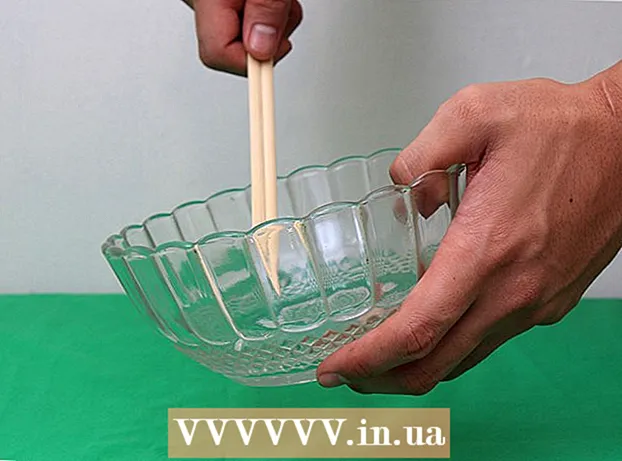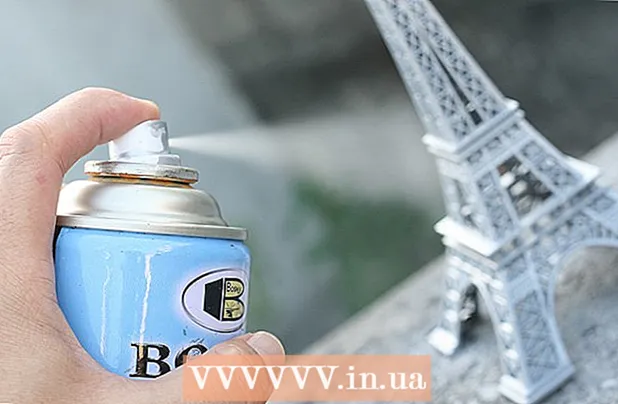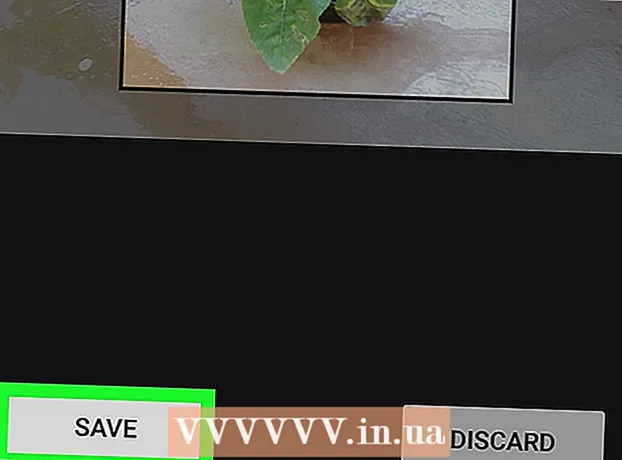Author:
Clyde Lopez
Date Of Creation:
23 June 2021
Update Date:
1 July 2024

Content
- Steps
- Part 1 of 3: Examining the Eyes for Infection
- Part 2 of 3: Treating an eye infection at home
- Part 3 of 3: Medical Treatment for an Eye Infection
Eye health is essential to the overall health of cats, so owners should regularly check their pet's eyes.To prevent long-term eye problems with your cat, it's important to know what to look for and how to act if an infection is found. Once you spot the problem early, you will have to decide whether to try to deal with the infection at home or go to the vet. When in doubt, be sure to seek professional help, as some problems can be very serious and even lead to loss of vision or an eye.
Steps
Part 1 of 3: Examining the Eyes for Infection
 1 Recognize the symptoms of an eye infection. Watch for symptoms of eye disease. An eye infection includes the following symptoms and their combination:
1 Recognize the symptoms of an eye infection. Watch for symptoms of eye disease. An eye infection includes the following symptoms and their combination: - A cat blinking or keeping an eye closed: This is an abnormal behavior that is a sign of pain or some discomfort in the eye. This can be due to trauma (scratching), increased pressure in the eye, a foreign body stuck under the eyelid, or inflammation in the eye.
- Swelling of the eyelids: Swollen, puffy eyelids are a sure sign of a problem -
usually as a result of injury, infection, or allergy.
- 1
- Discharge from the eye: All cats develop a viscous substance in the inner corner of the eye, especially when they blink or have not yet washed their face. Typically, this substance is clear or brown. When this clear liquid comes into contact with air, it dries up and turns brown like rust. It's quite normal. Yellow or green discharge is a sign of infection.
- Inflammation of the white of the eye: The whites of the eyes should remain white. A pinkish tint or swollen blood vessels indicate a problem, such as an allergy, infection, or glaucoma (increased pressure in the eye).
- Loss of gloss: the healthy eye has a pronounced reflective surface, so on close examination, all reflections should be solid and have smooth edges. If the surface of the eyes turns out to be cloudy, and the reflection is difficult to see, then something is wrong with the cat. This could be a sign of dry eyes (lack of tear fluid) or an ulcer on the surface of the eye.
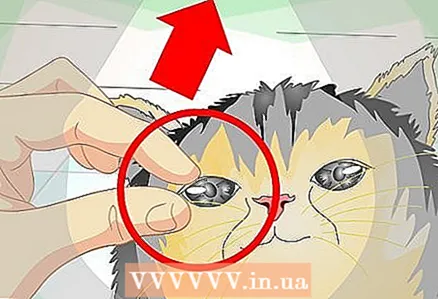 2 Examine the cat's eyes in daylight. If you notice that the animal has eye problems, examine them in daylight. Determine which eye is having problems by comparing one eye to the other. Examine the problem eye carefully and note for yourself the following: the color of the discharge, the presence of inflammation in the whites of the eye, the presence of pain, and so on.
2 Examine the cat's eyes in daylight. If you notice that the animal has eye problems, examine them in daylight. Determine which eye is having problems by comparing one eye to the other. Examine the problem eye carefully and note for yourself the following: the color of the discharge, the presence of inflammation in the whites of the eye, the presence of pain, and so on.  3 Decide whether to take your cat to the vet. Some infections require professional medical attention rather than home treatment. Take your cat to the veterinarian if you notice any of the following symptoms:
3 Decide whether to take your cat to the vet. Some infections require professional medical attention rather than home treatment. Take your cat to the veterinarian if you notice any of the following symptoms: - visible signs of discomfort (the cat closes its eye);
- yellow or green discharge;
- the eye has a matte surface;
- enlarged blood vessels on the surface of the eye.
Part 2 of 3: Treating an eye infection at home
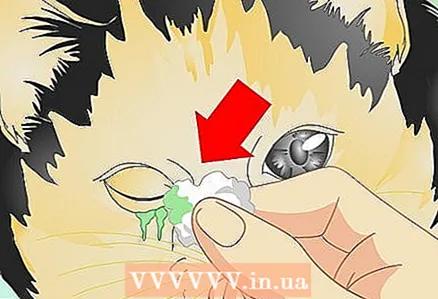 1 Clear eye discharge. If your cat has watery or fluid eyes, take a wet cotton swab and wipe them off. Wipe them down as often as necessary. In the case of a severe infection, this procedure will have to be done hourly.
1 Clear eye discharge. If your cat has watery or fluid eyes, take a wet cotton swab and wipe them off. Wipe them down as often as necessary. In the case of a severe infection, this procedure will have to be done hourly. - Dry your eyes dry.
- When the cotton wool gets dirty, take another one. Dry each eye with a separate cotton swab.
 2 Be especially careful with the kitten's eyes. In kittens with an eye infection, the eyes often stick together due to discharge. It is very important to clean them out in time, as the infection can accumulate over the centuries and cause blindness.
2 Be especially careful with the kitten's eyes. In kittens with an eye infection, the eyes often stick together due to discharge. It is very important to clean them out in time, as the infection can accumulate over the centuries and cause blindness. - If the eyelids are stuck together, soak a clean piece of cotton wool in pre-boiled (and already cooled) water. Wipe the eye with a wet cotton swab several times, moving from the inner corner of the eye to the outer corner. At the same time, use the thumb and forefinger of your other hand to gently move the upper and lower eyelids apart.
 3 Be careful not to get irritants in your cat's eyes. Trim long hairs to keep them out of your eyes, and keep your face clean.You should also avoid using aerosols if your cat is around, as his eyes are very sensitive and the aerosol can cause him to tear.
3 Be careful not to get irritants in your cat's eyes. Trim long hairs to keep them out of your eyes, and keep your face clean.You should also avoid using aerosols if your cat is around, as his eyes are very sensitive and the aerosol can cause him to tear.
Part 3 of 3: Medical Treatment for an Eye Infection
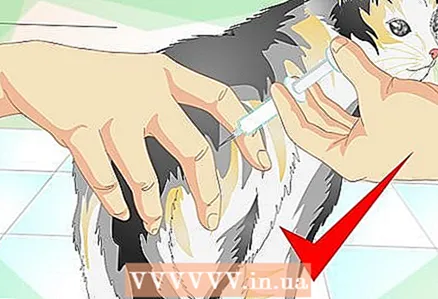 1 Don't forget about vaccinations. It may sound strange, but getting vaccinated can prevent some infections from developing. Two common causes of eye infections that can be prevented by vaccination are the common cold and chlamydia.
1 Don't forget about vaccinations. It may sound strange, but getting vaccinated can prevent some infections from developing. Two common causes of eye infections that can be prevented by vaccination are the common cold and chlamydia.  2 Take your cat to the veterinarian so that the infection can be examined and treated. Bacteria or viruses usually cause eye infections. Viral infections can clear up on their own. The cat's immune system will deal with it on its own. Bacterial infections are treated with eye ointments or drops that contain an antibiotic.
2 Take your cat to the veterinarian so that the infection can be examined and treated. Bacteria or viruses usually cause eye infections. Viral infections can clear up on their own. The cat's immune system will deal with it on its own. Bacterial infections are treated with eye ointments or drops that contain an antibiotic. - The viruses that infect the eye include herpesvirus and calicivirus. Some veterinarians prescribe a topical antibiotic even if a viral infection is suspected, as it may be co-running with a complicating bacterium that causes secondary infection.
- Bacteria that can enter the eye and cause infection include Staphylococcus aureus, Escherichia coli, Proteus, and Pseudomonas aeruginosa. Wash your hands every time you touch a cat with sticky eyes, as these types of infections are transmitted through touch.
 3 Apply the medicine as directed. Depending on the dosage form of the antibiotic, the drug should be given from twice a day to once an hour. Oral antibiotics are usually not given for eye infections. An exception may be cases when it is not possible to apply the ointment due to the capricious nature of the cat.
3 Apply the medicine as directed. Depending on the dosage form of the antibiotic, the drug should be given from twice a day to once an hour. Oral antibiotics are usually not given for eye infections. An exception may be cases when it is not possible to apply the ointment due to the capricious nature of the cat. - Treatment usually lasts at least five days and should not be interrupted prematurely due to the risk of antibiotic resistance.
